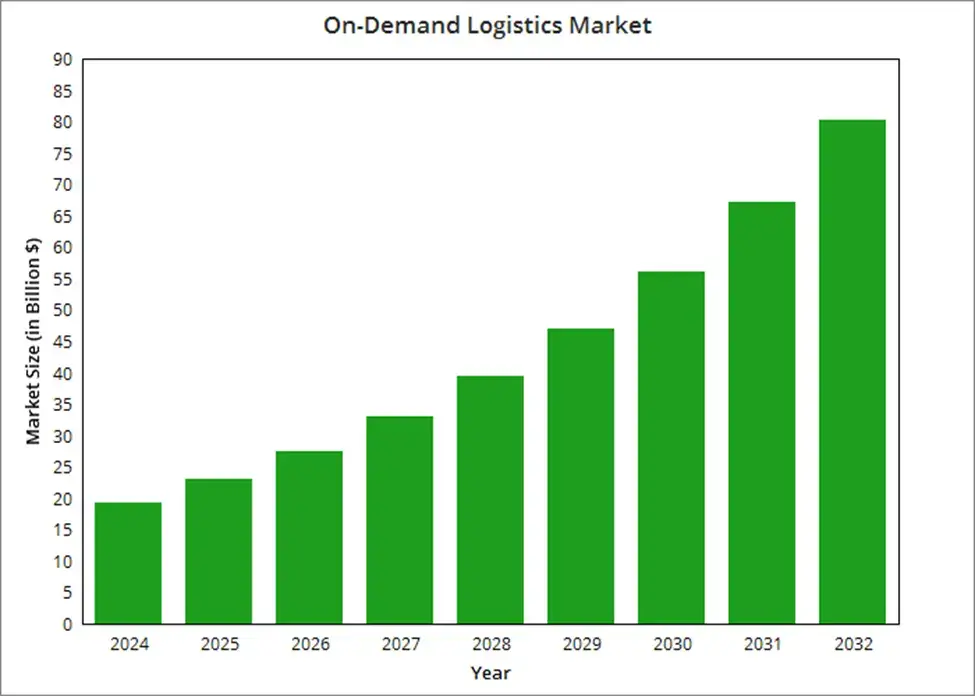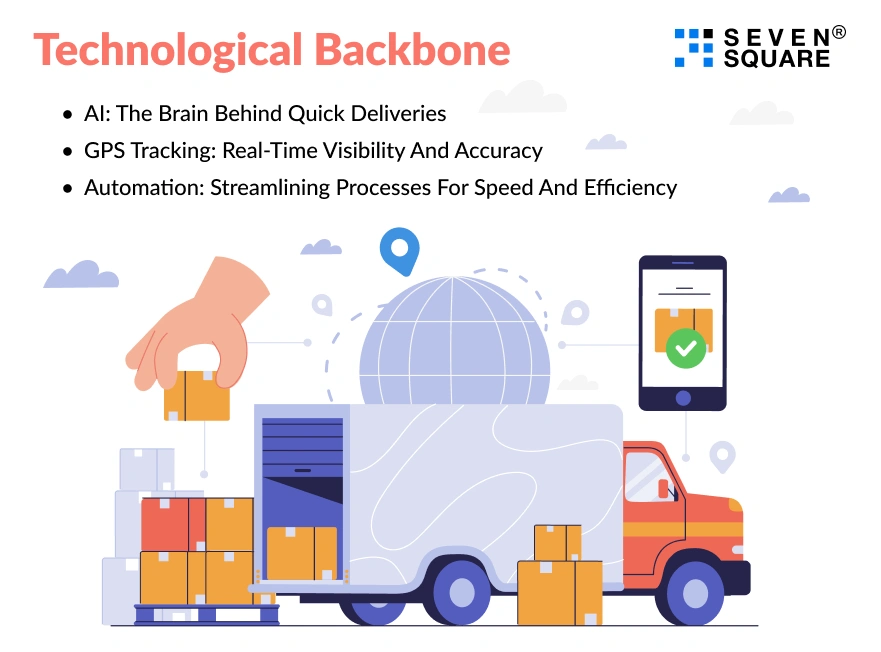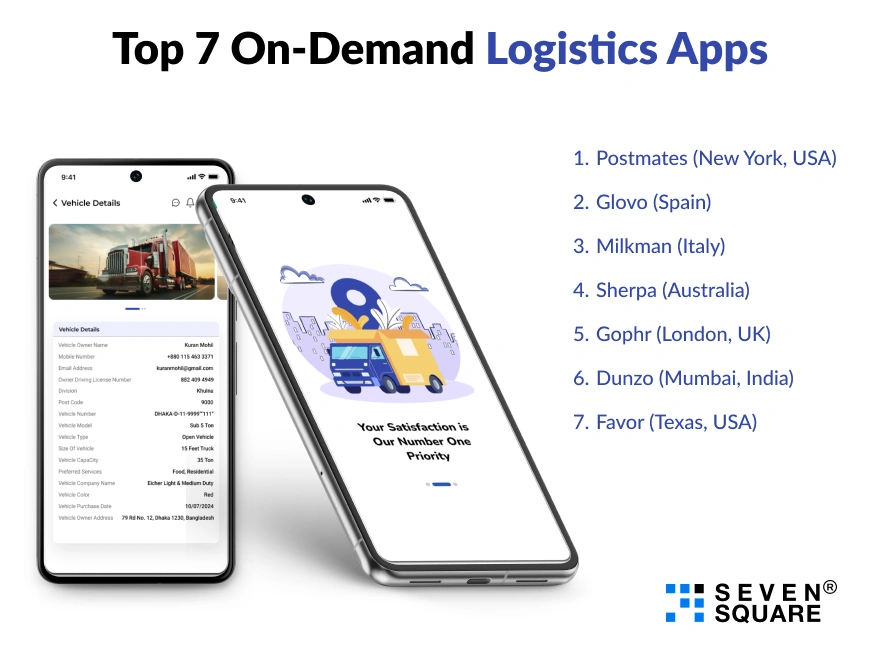Nowadays, customers prefer convenience and efficiency when buying products from eCommerce platforms.
On-demand logistics apps are highly important in the eCommerce industry.
But what exactly are these apps?

On-Demand Logistics market size is around 19.31$ billion in 2024 and it will reach 80.3$ billion in 2032 at a growth rate of 19.5%.
Don’t worry, we are here to answer. On-demand logistics apps work as a medium to connect consumers, businesses, and delivery partners in real time. They improve transporting products as quickly as possible from point A to point B.
On demand logistics apps use advanced technologies like GPS tracking, real-time communication, and automated dispatching so that deliveries can be done as soon as possible.
On-demand logistics apps are extremely important for eCommerce because online shopping is just going to increase in the future. Same-day delivery of the product used to be a luxury and now the demand for it is quickly increasing among the customers as they want their products quickly.
That’s why various eCommerce websites and stores are adopting faster delivery options to satisfy the customers’ requirements. For same-day delivery, on-demand logistics applications are the best choice so that your business can stay one step ahead of its competitors.
Same-Day Delivery Expectations
Today, customers expect their online orders to arrive on the same day. Almost 80% of customers want to get a same-day delivery option and 50% of customers say that they will shop from the eCommerce that provides same-day delivery.
Amazon Prime is one of the key eCommerce platforms that currently fulfils the same-day delivery requirement of customers.
Millions of Prime members are receiving their orders within hours or the same day so Amazon has been able to set a strong standard in the industry. That’s why various eCommerce platforms and websites are implementing on demand logistics apps to make same-day delivery possible.
Powering E-Commerce: The Inner Workings of On-Demand Logistics Apps:
On-demand logistics apps are the backbone of eCommerce solutions because they make it possible to deliver products faster than over. But are you still wondering how they work?
Don’t worry here you can see how these apps use a perfect combination of technology and smart algorithms. Now let’s understand the core functionalities of eCommerce platforms with their connectivity to real-time delivery apps.
Core Functionalities: Bridging E-Commerce with Real-Time Delivery Solutions
On-demand logistics apps can be smoothly integrated with eCommerce platforms to improve the overall shopping experience. Here you can see some of the key functionalities that a combination of eCommerce platform and logistic app offer to provide fast, reliable, and transparent deliveries for customers.
- Real-Time Tracking : These apps sync with eCommerce platforms so that customers can track their orders in real-time. This transparency keeps customers satisfied with lasted delivery updates.
- Order-Management : On-demand logistics apps can be integrated with eCommerce systems to simplify order processing. They efficiently handle order organization and prioritization to smoothly deliver products.
- Automated Dispatch : The apps quickly assign deliveries to the nearest drivers to optimize the dispatch process. It helps to deliver the product quickly without any delays.
- Inventory Management : On-demand logistics applications can also manage inventory by syncing with the eCommerce platform’s stock data to ensure that products are always in stock and available for immediate delivery.
- Customer Communication : They provide smooth communication between the customer, delivery driver, and business owner. Customers can receive updates via SMS or app notifications to stay in the loop.
- Payment Processing : Integrated payment gateways allow the customers to pay for their orders directly within the app. This integration also supports various payment methods so that customers can make payments according to their preferences.
- Return and Refund Management : Some on demand logistics apps can also handle returns and refunds. You have to integrate them with eCommerce platforms to provide an easy and efficient process for customers.
- Efficient Delivery Services : These apps work closely with eCommerce platforms to provide more dependable deliveries that are up to the expectations of the customers.
Technological Backbone: AI, GPS, and Automation in Action

The On demand logistics apps are modernizing the way goods can be delivered especially in the area of same-day delivery. But these apps’ user-friendly interfaces depend upon the complex technical backbone that makes it possible.
Technologies like Artificial Intelligence (AI), GPS tracking, and Automation play a very important role in improving route optimization, delivery, and overall efficiency. Let’s understand how these technologies work together for timely deliveries and better customer satisfaction.
AI: The Brain Behind Quick Deliveries
- On-demand logistics services apps can make logical decisions as they are powered by artificial intelligence.
- A large number of data can be analyzed by artificial intelligence in real-time so that the app can make quick decisions like optimizing delivery routes, anticipating delays, etc.
1. Route Optimization : AI plays an important role in route optimization because it analyzes traffic patterns, weather conditions, and other variables that could impact delivery times.
- For example, if there’s a traffic jam then the AI system quickly recalculates the route and suggests the fastest alternative. This dynamic route ensures that drivers take the most efficient paths that reduce delivery times and minimum fuel consumption.
2. Predictive Analysis : AI also uses predictive analytics to predict the demand for optimizing resource allocation.
- By analyzing the historical data, the system can predict peak delivery times to ensure that more drivers are available to fulfill demand. This helps prevent delays and ensures that customers receive their orders on time.
3. Personalized Customer Experience : Artificial intelligence is used to improve customer satisfaction by providing personalized delivery options according to the preferences of users.
- For example, the system will provide specific time slots for delivery when a customer is usually home. This customization improves the overall user experience and builds loyalty among customers.
Automation: Streamlining Processes for Speed and Efficiency
- Automation is the backbone of operational efficiency in on-demand logistics service apps.
- By automating routine tasks these apps can easily handle more orders while maintaining speed and accuracy.
Real-World Examples: Technology in Action
Some leading logistics companies are already using these technologies and some of them are mentioned here:
- Amazon uses AI-based algorithms to optimize the delivery routes so that its huge network of delivery drivers can fulfill the high demand for same-day deliveries. They use GPS tracking so that customers can monitor their orders in real-time to provide reliable delivery service.
- Uber Eats uses AI and automation to manage its delivery network. Its AI system predicts demand in specific areas and ensures that enough drivers are available. GPS tracking provides customers with real-time updates about their food delivery while automation simplifies the entire process from order placement to dispatch.
Case Studies: Innovation in Action with CountME and Nawee
At Seven Square we have worked on two promising logistics and courier apps that provide fast, reliable, and efficient delivery services. These on-demand logistics services apps are CountME and Nawee.
Both have unique functionalities that satisfy specific eCommerce requirements and here you can learn about their advanced features and how they are changing the logistics industry. Let’s explore the common functionalities that can be seen in these two applications.
- User Registration & Login : Simplifies user onboarding by providing a smooth registration and login process so users can quickly start using the app & manage profiles securely.
- Real-Time Tracking : Get complete visibility for the deliveries and users can track the progress of their packages in real-time.
- Route Optimization : Improves delivery efficiency by automatically calculating the best routes so drivers can make faster deliveries for customers.
- ETA Calculation : Provides accurate estimated delivery times so customers can plan accordingly and minimize the waiting time.
- Push Notifications : It gives regular updates to users about delivery status minimizing the requirement for manual tracking.
- Delivery Confirmation : The customers get instant confirmation of successful deliveries to ensure transparency and build trust in the service.
- Customer Support : Offers in-app customer support services so that users can quickly resolve issues or get assistance for higher satisfaction.
- Order History : Enjoy past delivery details so that users can go through past transactions and monitor their delivery activities.
- Inventory Management : Ensures that stock of products is continuously tracked and updated to minimize the risk of order cancellations because of out-of-stock items.
- Third-Party APIs : Our developers integrated third-party APIs to connect the app with other systems and platforms.
- Route History : Provides a record of previous routes taken by drivers to help businesses analyze and optimize delivery paths for the future.
- In-App Messaging : With this feature customers, drivers, and businesses can have smooth communication to minimize the misunderstanding during deliveries.
- Bulk Order Processing : Simplifies the handling of multiple orders at once so that businesses can manage high-volume deliveries efficiently.
- Driver Navigation : Drivers get built-in GPS navigation so they can find the best possible routes and deliver the products quickly.
- Insurance Integration : Customers can insure their packages and don’t worry while going through the delivery process.
1. CountME: Simplifying Multi-Pickup and Multi-Delivery Logistics
Some leading logistics companies are already using these technologies and some of them are mentioned here:
- CountME is an on-demand logistics app that we created to manage complex multi-pickup and multi-delivery scenarios.
- It allows the app to handle multiple orders while ensuring that products from different locations can be picked up and delivered to various destinations within the same route.
- CountME saves a lot of time and also optimizes delivery costs. That’s why it has become a preferred choice for businesses with diverse delivery needs.
- Multi-Pickup and Multi-Delivery : This feature allows one to manage multiple pickups from various locations while ensuring their timely deliveries to multiple destinations.
- Payment Gateways : We integrated multiple payment gateways in the CountME app so that customers can have safe payment options within the app.
- Live Tracking : It is one of the most important features of CountME where customers can easily monitor their deliveries while the products are on the way for delivery.
2. Nawee: All-Inclusive Solution for Diverse Delivery Needs
Some leading logistics companies are already using these technologies and some of them are mentioned here:
- Nawee is an innovative on-demand logistics services app that comes with various features that can fulfill the needs of modern eCommerce.
- Nawee stands out for its ability to handle not only multi-pickup and multi-delivery scenarios but also for its advanced functionalities that serve specialized delivery requirements.
- Multi-Pickup and Multi-Delivery : Like CountME, Nawee’s multi-pickup and multi-delivery feature ensures that multiple orders can be efficiently managed and delivered to optimize routes and reduce costs.
- Booth Option : Nawee provides a unique booth option so that delivery agents can pick up the orders from designated booths and it is useful for businesses that offer alternative pickup locations.
- Agent and Commission : We integrated this feature to manage agents and their commissions. Businesses can easily track and pay their delivery agents. It automates the commission process while ensuring accurate and regular payments.
- Live Tracking : Provides real-time tracking service so that customers can monitor their deliveries to improve overall experience.
- Temperature Maintain : Nawee goes one step further by providing temperature-controlled deliveries. Businesses need to handle items that require specific temperatures during transportation.
Top 7 On-Demand Logistics Apps

Go through some of the leading on-demand logistics apps from different parts of the world.
1. Postmates (New York, USA)
- Postmates is one of the most popular on-demand logistics platforms in the United States. It offers fast and reliable delivery services including everything like groceries and takeout.
2. Glovo (Spain)
- Glovo is an app that delivers anything you need within an hour. It has expanded its reach to various countries & it has become Europe’s one of the most recognized on-demand delivery services apps.
3. Milkman (Italy)
- Milkman is a logistics app that focuses on the delivery experience & offers flexible and convenient delivery options to customers all over Italy.
4. Sherpa (Australia)
- Sherpa is an Australian on-demand delivery service app that helps businesses and users who need reliable courier services within urban areas.
5. Gophr (London, UK)
- Gophr is a London-based on-demand courier service app that provides quick, flexible, and reliable deliveries across the UK.
6. Dunzo (Mumbai, India)
- Dunzo is a leading on-demand services app in India that provides various delivery options like groceries and packages.
7. Favor (Texas, USA)
- Favor is an on-demand delivery services app that has a strong presence in Texas and is known for its customer-centric approach to deliver various products.
Business Challenges in On-Demand Logistics Apps and Their Solutions
Go through some of the leading on-demand logistics apps from different parts of the world.
1. Scalability and Demand Fluctuations
- Challenge : During peak hours there can be a lot of pressure on resources and it can affect service quality.
- Solution : To overcome this challenge you need to implement scalable cloud infrastructure and use predictive analytics to predict demand patterns so that you can dynamically allocate the resources even during high demand.
2. Operational Costs
- Challenge : High operational costs like fuel, vehicle maintenance, etc. can affect the overall profitability.
- Solution : Utilize route optimization software and energy-efficient vehicles to minimize fuel consumption & maintenance costs. Automating routine tasks can help minimize labor costs.
3. Regulatory Compliance
- Challenge : Following various regulations in different regions like vehicle standards, labor laws, and environmental policies can be complex and time-consuming.
- Solution : Stay updated with regulatory changes using compliance management software and work with legal experts to ensure your business follows all the local laws.
4. Customer Expectations and Service Reliability
- Challenge : Nowadays customers expect fast, reliable, and transparent delivery services. If you can’t provide it then you can have negative reviews and loss in business.
- Solution : Use real-time tracking and communication tools to connect with customers. Create a customer support system that can resolve any issues.
5. Technology Integration
- Challenge : Businesses often face compatibility issues while integrating new technologies into your existing systems.
- Solution : Follow a modular and API-driven approach for system integration. It ensures smooth connectivity between various technologies and minimizes the risk of disruptions.
6. Security and Data Privacy
- Challenge : Protecting customer data from cyber-attacks is important, especially for the industry that manages a large number of transactions.
- Solution : You need to implement robust cybersecurity standards like encryption, firewalls, and regular security audits to protect customer’s information.
7. Last-Mile Delivery Challenges
- Challenge : It is one of the most expensive and complex parts of the delivery process and delivery partners often face challenges like traffic congestion, small delivery windows, and remote locations.
- Solution : To overcome this challenge you need to implement advanced routing algorithms, local delivery hubs, and crowd-sourced delivery models.
8. Workforce Management
- Challenge : Managing a diverse workforce can be difficult as it includes drivers, warehouse staff, and customer service representatives who ensure flawless services.
- Solution : Implement workforce management software to track performance, schedule shifts, and communication among team members.
Want to get an On-Demand Logistics App? Contact Us Now to Get Fully Featured App!
FAQs
- Various on-demand logistics apps use real-time tracking, advanced route optimization, and automated dispatch systems to ensure that packages are picked up and delivered within the same day.
- You can integrate the app with eCommerce platforms to simplify the entire delivery process and make same-day delivery possible.
AI is one of the key technologies for same-day delivery in logistics apps for demand forecasting and route optimization. GPS for real-time tracking, and automation to simplify the order processing and dispatch.
To make on-demand logistics apps better than traditional ones you need to implement unique features like real-time tracking, better efficiency, customer experience, data analytics, scalability, sustainability, flexibility, and many more.
On-demand logistics apps use route optimization algorithms and communication helps to prevent delays while providing real-time adjustments to solve any issues that can arise during delivery.
- To ensure the app’s scalability you need to build the app on a cloud-based infrastructure to easily handle increased traffic and data loads.
- Its architecture and microservices help to add new features without disrupting existing functionalities as your business grows.
The initial steps include defining your business requirements, selecting the right technology stack, designing the user interface, and developing core features like order management, real-time tracking, payment integration, and many more.